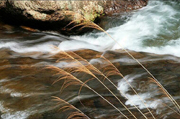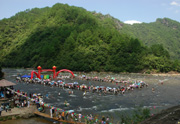Wooden Arcade Bridges in Pingnan
( chinadaily.com.cn )
Updated: 2011-04-07
The oldest wooden arcade bridge in Pingnan was first built in the Song Dynasty. Other bridges in the town were first built in the Yuan, Ming and Qing dynasties. Today’s wooden arcade bridges have been rebuilt or repaired many times. According to records in the old county annals, village history and bridge tablets, the bridges first built in the Song Dynasty are Wan’an Bridge, Qiancheng Bridge, Longjing Bridge, Baixiang Bridge and Guangli Bridge; the bridge first built in the Yuan Dynasty is Guangfu Bridge; and the bridges first built in the Ming and Qing dynasties are Longjin Bridge, Jinzhao Bridge, Qingyan Bridge, Huifeng Bridge, Xili Bridge, Zhangkou Bridge and Yingfeng Bridge.
The wooden arcade bridges in Pingnan basically each adopt the same wooden arch structure, in which 61 round cedar longitudinal beams and 10 transverse beams are connected with mortises and tenons to form a splayed bridge arch. Eight beams constitute four “X”-shape scissor forks to prevent the bridge arch from swaying left and right, rods are inserted into the arch to form the arch support, and planks are transversely paved on the support to form the bridge deck.
A bridge house, adopting a column and tie construction containing 4 columns and 9 purlins, is built on the bridge deck, and the house adopts a double-slope roof or an overhanging gable roof. The whole bridge doesn’t have a single nail and is joined together with inlaying of purlins and rafters. The structure is stable. The bottom is arced and the deck is flat. The architectural skills behind the building of the bridge are original and smart and reflect the intelligence and craftsmanship of the Chinese ancient bridge builders. These unique buildings, half-bridges half-houses resemble Bianshuihong Bridge in the painting “Riverside Scene at Qingming Festival” created by Zhang Zeduan in the Song Dynasty.
However, compared with Bianshuihong Bridge, the arcade bridges substituted Bianshuihong’s tying structure with a mortise and tenon structure, representing a vast improvement to the bridge building technology. Moreover, they also introduced the bridge houses. In the middle of a bridge house, there is a corridor-type passageway with a width of above 2m. On the two sides, there are fixed long wooden stools. The building date and the names of donors, bridge building directors, and bridge builders are recorded on the beams of the bridge house. In some bridges, very interesting and well-worded couplets were written, too.






